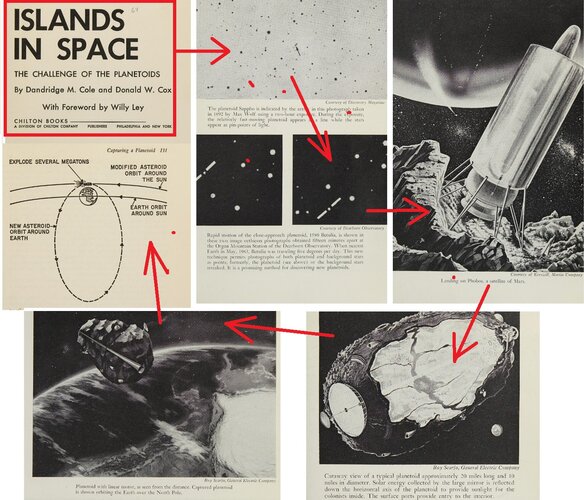LoveFromRussia
life is discovery
- Joined
- 16 September 2022
- Messages
- 20
- Reaction score
- 56
On September 26-27, the DART probe successfully collided with the asteroid Dimorph.
The plan for this experiment on a futuristic megalomaniac scale was published in 1964.
I have a 1964 e-book in my collection: Dandridge Cole Donald Cox Islands in Space The Challenge of the Planetoids 1964. Dr. Dandridge Cole writes there: we calculate a planetoid near the Earth; we fly to this planetoid on the nuclear-pulse spaceship Orion or Aldebaran; we land on this unfortunate planetoid; we build a habitable cavity inside the planetoid; we build engines outside the planetoid; we turn the unfortunate planetoid into a habitable space ferry; and our trained asteroid flies according to our program in the solar system.
I show this on fragments of the pages of the book.
But Dr. Cole was a great prestidigitator. After a modest first book, he published a grandiose coffeetable album for the richest corporations - «Beyond tomorrow: The next 50 years in space».
After this album, everyone forgot about Dr. Dandridge Cole. Moral: modest plans are real, Napoleonic plans are utopian.
The plan for this experiment on a futuristic megalomaniac scale was published in 1964.
I have a 1964 e-book in my collection: Dandridge Cole Donald Cox Islands in Space The Challenge of the Planetoids 1964. Dr. Dandridge Cole writes there: we calculate a planetoid near the Earth; we fly to this planetoid on the nuclear-pulse spaceship Orion or Aldebaran; we land on this unfortunate planetoid; we build a habitable cavity inside the planetoid; we build engines outside the planetoid; we turn the unfortunate planetoid into a habitable space ferry; and our trained asteroid flies according to our program in the solar system.
I show this on fragments of the pages of the book.
But Dr. Cole was a great prestidigitator. After a modest first book, he published a grandiose coffeetable album for the richest corporations - «Beyond tomorrow: The next 50 years in space».
After this album, everyone forgot about Dr. Dandridge Cole. Moral: modest plans are real, Napoleonic plans are utopian.

